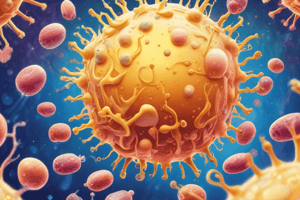Podcast
Questions and Answers
What is Staphylococcus aureus characterized by?
What is Staphylococcus aureus characterized by?
- Sporefoming Aerobic
- G(-) Bacilli
- G(+) Cocci in grape-like clusters (correct)
- G(+) Cocci in chains
What infections are associated with Staphylococcus aureus?
What infections are associated with Staphylococcus aureus?
Skin infections, sty, boils, furuncles, carbuncles, impetigo, scalded skin syndrome
Staphylococcus epidermidis is often associated with ________ syndrome.
Staphylococcus epidermidis is often associated with ________ syndrome.
toxic shock
Streptococcus pneumoniae is communicable.
Streptococcus pneumoniae is communicable.
What is a common mode of transmission for Streptococcus pyogenes?
What is a common mode of transmission for Streptococcus pyogenes?
Which of the following is NOT a distinct symptom of Bacillus anthracis?
Which of the following is NOT a distinct symptom of Bacillus anthracis?
How should animal carcasses connected to Bacillus anthracis be disposed of?
How should animal carcasses connected to Bacillus anthracis be disposed of?
The signs and symptoms of Staphylococcus aureus infections include ________ with pus.
The signs and symptoms of Staphylococcus aureus infections include ________ with pus.
Match the pathogens with their distinct characteristics:
Match the pathogens with their distinct characteristics:
Flashcards are hidden until you start studying
Study Notes
Staphylococcus aureus
- Gram-positive cocci forming grape-like clusters; natural flora of the skin.
- Catalase positive; capable of producing yellow colonies.
- Notable for methicillin-resistant strains (MRSA) and vancomycin-resistant strains (VRSA).
- Causes various skin infections such as sty, boils, furuncles, carbuncles, and impetigo.
- Can lead to scalded skin syndrome characterized by abscess formation containing pus.
- Typically not communicable; hygiene and immune support are important for control.
Staphylococcus epidermidis
- Associated with toxic shock syndrome.
- Symptoms include fever, vomiting, diarrhea, hypotension, rash, and multiple organ involvement without fever.
- Typically not communicable; reinforced hygiene practices are necessary for prevention.
Staphylococcus saprophyticus
- Linked to gastroenteritis.
- Possible complications include strep throat and scarlet fever, which can lead to rheumatic fever or glomerulonephritis.
- Primarily transmitted through oral-fecal routes; typically not communicable.
- Control through enhanced hygiene and sanitation.
Streptococcus pyogenes
- Gram-positive cocci arranged in chains; encapsulated with varying hemolytic properties (α, β, γ).
- Causes pharyngitis and pharyngotonsilitis.
- Signs include vesicles and pustules in the throat.
- Usually not communicable; strong emphasis on hygiene and sanitation along with immune response management.
Streptococcus pneumoniae
- Gram-positive cocci appearing in pairs or short chains, characterized by a lancet shape; encapsulated and alpha hemolytic.
- Associated with puerperal sepsis and pneumonia.
- Symptoms include lymphadenopathy, fiery red advancing erythema on face and limbs, and systemic infection indicators like fever and sharp pleural pain with a rusty-colored alveolar exudate.
- Typically not communicable; transmission primarily through respiratory droplets, affecting immunocompromised individuals.
- Prevention strategies include hygiene, surgical asepsis, personal protective equipment (PPE), isolation, and immune enhancement.
Bacillus anthracis
- Gram-positive, spore-forming bacilli with a cut-glass appearance and central endospores.
- Causes inhalation anthrax, gastrointestinal anthrax, and cutaneous anthrax.
- Symptoms vary from mediastinitis, sepsis, and meningitis to hemorrhagic pulmonary edema, along with severe abdominal pain and bloody diarrhea in gastrointestinal cases.
- Rapidly fatal in severe cases with necrotic ulcers that disseminate into the bloodstream.
- Transmission methods include inhalation, ingestion of spores, or entry through open wounds.
- Control measures include incineration or deep burial of infected animal carcasses, decontamination of animal products, and use of protective clothing while handling infected materials.
Studying That Suits You
Use AI to generate personalized quizzes and flashcards to suit your learning preferences.





